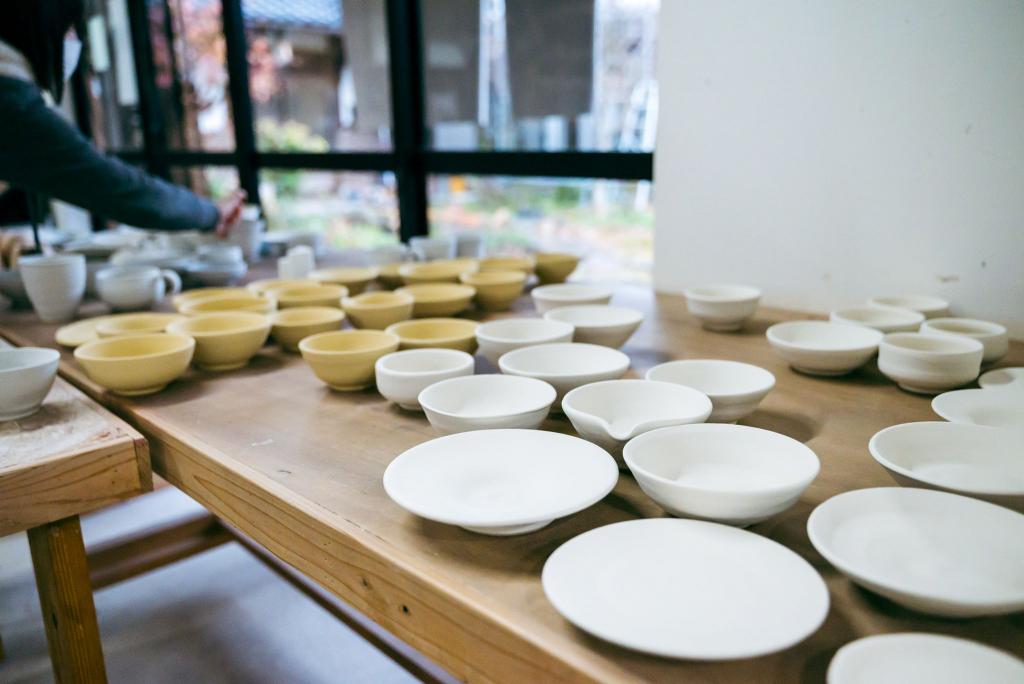Kyushu is famed throughout the world for its ceramics. Although Arita ware from neighboring Saga Prefecture tends to get the most attention, Kumamoto also has a long history of unique and beautiful ceramics. Traditional styles like Shodai and Koda wares originated in Kumamoto, and the Amakusa region is renowned for its excellent porcelain stone.
Online information about pottery workshops can be sparse, so here we’ve listed a couple places worth visiting in Kumamoto.

Kumamoto Prefectural Traditional Crafts Center
The Traditional Crafts Center is a museum and shop located near the castle that showcases a variety of crafts made in Kumamoto Prefecture. On the first floor, you’ll find a large shop featuring local pottery, knives, and other crafts. In addition to traditional ceramic styles, the shop also features work from potters who work in modern styles with bold, colorful designs and cute motifs.



The second floor of the center is a museum of various Kumamoto crafts, including pottery, woodwork, bamboo weaving, and more. There are also a few galleries featuring temporary exhibits.
The center also offers frequent craft workshops. Check out their website (in Japanese) for workshop and exhibit schedules.
Kumamoto Prefectural Traditional Crafts Center
Address: 3-35 Chibajo-machi, Chuo-ku, Kumamoto City
Website: https://kumamoto-kougeikan.jp/
Hanabusagama

Located just a 15-minute walk/7-min drive from downtown Kumamoto City, Hanabusagama is the studio of ceramic artist Hideo Maeda (Full member, Japan Kogei Association). Maeda-sensei produces many styles of ceramic, often with bold colors and intricate patterns that combine traditional Japanese techniques with innovative designs. Many of his pieces have been selected for the Japan Traditional Kogei Exhibition, Japan’s greatest authority on traditional crafts. Some of his artwork is even on display in art museums in the US and France!




Hanabusagama also offers pottery lessons and a gallery with a variety of pieces for sale.
I took a 2-hour course with an electric pottery wheel. As a first-timer, it was interesting to see how the clay needs to be kneaded before working with it, and how the clay needed to be further worked on the wheel before you could start making pottery.


Once the clay was ready, I made a pillar of clay in the center of the wheel. Next, you make a little dimple in the clay and slowly push and stretch the clay until you have a nice little bowl or cup. Then you slice what you made off the pillar with a piece of wire and start making your next work of art!




Once you’ve crafted your pottery, next you get to pick your glaze. Most pottery classes only offer a couple glazes to choose from, but Hanabusagama offers a selection of 14 different glazes. One of the glazes is significantly more expensive than the others—see if you can guess which one!

After you pick your glaze, your pottery will be sent to you after it has been fired and glazed. All-in-all, the process takes about 1 month before your pottery is ready for shipping to you.
Hanabusagama
Address: 9-23 Tsuboi 5-chome, Chuo-ku, Kumamoto City
Website: https://www.hanabusagama.jp/
Gengama

Gengama is a lively pottery workshop on the northern outskirts of Kumamoto City. The kiln is headed by Hiroyuki Saito, a young artist who only started making pottery in 2012 but has already made quite a name for himself through collaborations with other local artists and chefs.

Gengama has a spacious gallery on the second floor featuring different styles of pottery made by Mr. Saito, ceramic jewelry made by his wife Hitomi, and work by other artists at the workshop who make things like noh masks and fashion accessories.

The first floor is dedicated to pottery-making, and features racks of pottery waiting to be glazed and fired. Gengama also offers a number of different pottery lessons, including pottery wheel lessons and plate-making workshops.


Saryoshohaku

Saryoshohaku is a chic new café and pottery gallery located on the omotesando (entrance street) to Suizenji Jojuen Garden. The right half of the shop features a collection of ceramics made in Kumamoto that are available for sale. The left half of the shop is occupied by a simple café offering light fare, sweets, and drinks.


The gallery has a rotating selection of works made by local artisans. At the café, I ordered a limited set consisting of inari sushi and hot tofu made with a local leafy green called Suizenji-na. Both items were delicious and make a perfect snack after a stroll through Suizenji.

Saryoshohaku
Address: 7-2 Suizenji Koen, Chuo-ku, Kumamoto City
Instagram: https://www.instagram.com/saryoshohaku/


